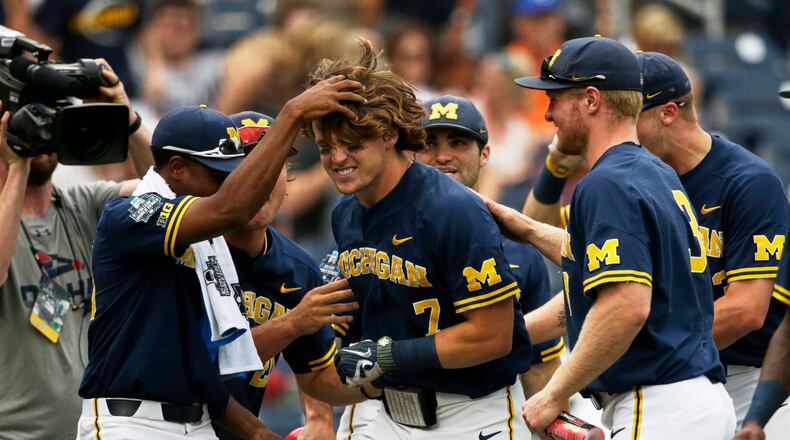Fans’ mood surrounding the Braves’ draft Thursday night: underwhelming.
The Braves’ haul (or rather, basket) included four college players: Lefty Jared Shuster (No. 25), outfielder Jesse Franklin (No. 97), righty Spencer Strider (No. 126) and righty Bryce Elder (No. 156). The Braves were down a pick (second round) in the already trimmed draft, but they feel like they made the most of it.
“These guys are pretty much mastering their craft,” vice president of scouting Dana Brown said. “Not only do they have talent, they’ve been able to develop the skill which we think is going to lead to something so they could move along pretty quickly.”
Yet the team’s satisfaction didn’t quell fans’ uneasiness. Baseball America, MLB Pipeline and other outlets publish their pre-draft rankings. By those values, the Braves overdrafted several players. Now, this isn’t a black-and-white exercise, and factors such as signability and personal preference play a sizable role.
We don’t have the whole picture. And most of us can’t even fall back on our own eye tests as we’d do in the NFL or NBA draft. So for people to be disappointed by the team’s draft – that is fair from a fan perspective. The class lacked flash and three picks didn’t align with projected values, and that’s really all most go off of.
For instance, the Braves took Shuster at No. 25. Baseball America ranked him the 43rd overall prospect. MLB Pipeline placed him at 77. The Braves took Franklin at 97, 54 spots earlier than he ranked on Baseball America’s list. Strider didn’t crack the top 200, but Elder represented some value as the 83rd ranked player sliding to 156 (for signability reasons, Brown said).
Does any of that matter? Well, no. Every year we learn how inexact a science any draft is. But these rankings do give us background information on players. They provide us talking points when we’re writing or reading about a team’s picks.
(Cue a mandatory reference to Mike Trout falling to the 25th pick.)
So I’m not going to tell you you’re wrong for disliking, or feeling underwhelmed, by this class. I hadn’t seen any of these players before Wednesday night either. And I’m not going to pretend to be an expert now.
One more note: This also was the first draft in a while in which the Braves weren’t picking in the top 10. I recommend getting used to that.
My biggest takeaway: The Braves are betting on their development here. They opted for traits and projection over production, in most instances. Their recent player-development track record is impressive, so they’ve earned the benefit of the doubt.
I don’t see huge potential in any of their draftees. The class feels more high floor, modest ceiling. The Braves already have young stars on their major-league club with a few others nearing promotions. The system’s depth needed addressing, so taking safer players who are likelier to become major-league contributors is a sound strategy.
As great as the Braves’ farm has been, graduations and the big-league team contending (trades, draft lower) cut into the system. While the Braves’ farm won’t be among the top five in a year or so, taking surer talents can help keep it afloat while the team rebuffs its lower levels.
Before we move on to the next thing – which very well could be the declaration of a season – let's revisit the Braves' small draft bundle one more time. They'll be adding to this group soon, too, given that undrafted free agency began Sunday morning.
Wake Forest left-hander Jared Shuster
The more I’ve read and heard about Shuster, the more interested I am. The raw numbers aren’t exciting. His college ERA exceeded 6.00, which perfectly illustrates how scouting is more about process than results.
Those results came late for Shuster, who put it together at the Cape Cod League last summer. Even then, his velocity hadn’t made the leap it did this spring. He went from hovering in the high-80s to consistently sitting 91-95 mph through four starts this season.
If you’re looking for a stand-out trait: His change-up produced a 64-percent whiff rate in 2019. It rated as one of the best changes in the class and clearly is Shuster’s best pitch.
Analysts and scouting gurus seem to agree that Shuster is a potential third or fourth starter. Very, very few pitchers are labeled potential top-of-the-rotation starters, and being projected as a potential middle-or-back-end starter is not a bad thing (despite the negative connotation it occasionally carries).
I won’t disagree, though, that it’s not exciting. We knew the Braves would go pitching. We suspected it’d be a college arm. Many clamored for Cole Wilcox there, the big righty from UGA. He was expensive to sign, which pushed him to the third round, with the Padres likely requiring more than $3 million to get that done. The Braves didn’t have much money to play with this time around (the third-smallest pool in baseball).
Shuster, meanwhile, should be an under-slot signing. So was Ian Anderson, whom the team drafted No. 3 overall four years ago and now ranks as the organization's No. 1 pitching prospect. Shuster's growth will be an intriguing storyline over the next couple of years.
Michigan outfielder Jesse Franklin
Franklin’s stock soared last season, when he hit .262/.388/.477 with 13 homers and 55 RBIs for a mighty Wolverines team. He broke his collarbone in a skiing accident before the truncated season, preventing him from playing.
Franklin has the potential to be a power-speed threat, but that hasn’t materialized yet. He’s lauded for his work ethic and landed in an optimal situation, which helps his case. Franklin is a bit raw, but his natural ability intrigues. He’ll join Greyson Jenista and Michael Harris in the Braves’ next wave of toolsy outfield talent.
“He’ll grow into some power,” Brown said. “I saw it more so in batting practice, so he’s got some raw power. Because of the swing and the way it looks, we feel like he’ll be able to get into a lot of that power.”
Clemson right-hander Spencer Strider
I’m most interested in this pick because Strider seems to have more than what he’s shown thus far. The Braves must concur, since they made him a fourth-round pick as a draft-eligible sophomore. Strider wasn’t a lock to be drafted at all.
Strider’s resume includes being Gatorade’s player of the year for Tennessee his senior year of high school. He was a top recruit and freshman All-American, posting gaudy strikeout numbers as a starter and reliever. His 12.35 strikeouts per nine innings was the fourth-best mark in Clemson history.
He was excellent out of the bullpen, earning a 2.59 ERA in 16 appearances. Brown said the Braves view him as a starter, but he could eventually find his way back to relieving long term. He missed the 2019 season because of Tommy John surgery but is fully healthy now, according to Brown.
I’m not sure what Strider at his best will look like, but there are multiple avenues that make him intriguing. He’s made just four appearances over the past two years. His freshman season showed a raw player with plenty of promise. His biggest issue – inconsistent command – isn’t an easy fix. But I’ll be curious to see if the Braves’ belief in him winds up rewarded. He has a low floor but moderate upside.
Texas right-hander Bryce Elder
The Braves felt landing Elder in the fifth round was a coup. They considered him a third-round value. Brown said he’ll require an overpay, but acquiring a player of his talents later in the draft helps make up for lacking a second-rounder.
Elder checks most boxes. He led a strong rotation at a big-time, winning program. It feels like there’s some untapped ability there, considering 1) baseball wasn’t his priority until later in high school, leaving him undrafted before joining Texas, and 2) he’s greatly improved since his freshman season, when he posted a 5.55 ERA in 22 games.
His sophomore jump included lowering his ERA to 2.93 and fanning 86 batters over 83 innings. He struck out 32 across 18 innings in the recent short season, earning Collegiate Baseball’s second-team All-American honors.
Elder’s best pitch is a slider, but his overall repertoire is more “solid” than “elite,” which is OK with a player at this stage of the draft. Evaluators’ consensus is Elder could be a back-end starter, again leading one to believe the Braves wanted to go the safer route.
Final point on Elder: One teammate praised him as the best leader he’s been around. Texas coach David Pierce said Elder is one of best pitchers he’s coached. Part of Elder’s appeal is his character and work ethic – a theme in this draft – that raises the likelihood he becomes a major-league caliber player.
About the Author
Keep Reading
The Latest
Featured



